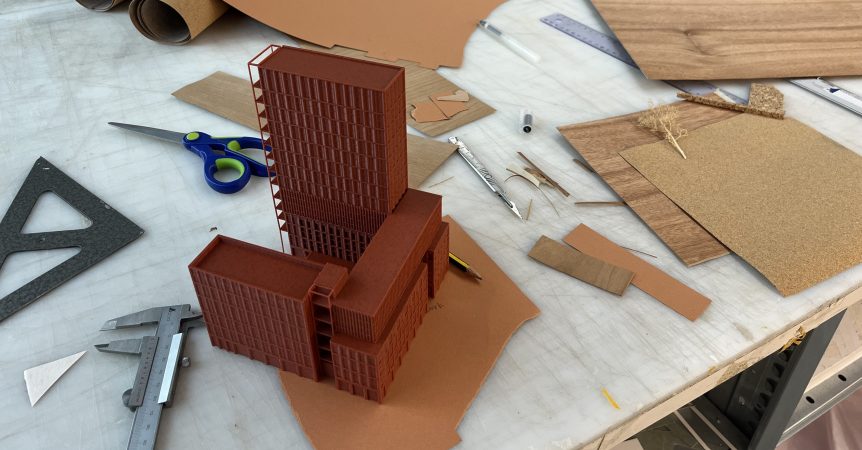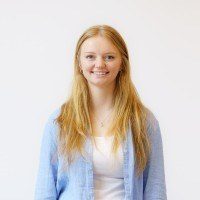Scan Design Foundation's Copenhagen Architecture Internship
Oct 28, 2024
My name is Shannon Payne, and I am a recent graduate student who had the privilege to work as an intern in Copenhagen for the past eight months. One hope I had going into this internship was to learn more about the design, culture, and people in Denmark, and I definitely did that. This opportunity was made available through the Scan Design Intern Exchange program, where graduate students from the University of Washington College of Built Environments are able to work for a short period at some of the most innovative firms in Denmark. As a result, I have been living in Copenhagen and traveling around Denmark while working at Cobe.
Internship with Cobe Architecture Firm
Cobe’s relationship with the University of Washington began when its founder, Dan Stubbergaard, co-taught a group of architecture students at the UW College of Built Environments through the Scan Design Foundation’s visiting professor program starting in 2015. Cobe has grown significantly in twenty years, and at the start of my internship in early 2024 the office housed almost 150 employees under one roof. As one of Cobe’s many transformation projects, the Cobe office is an old warehouse that sits along the water in Nordhavn. The masterplan of the area was envisioned by urban planners at Cobe not so long ago, so it was exciting to be able to work in an area that was still being planned by the people around me.
Most of my time at the office was spent working on an affordable housing project in Toronto, Ontario, Canada, and a small landscape design project close to the Copenhagen waterfront. While I gained a lot of technical expertise from working on the Toronto project, some of my most beneficial takeaways were the communication skills I gained from having a relatively consistent schedule with the project. Because the other half of our design team was made up of local architects in Canada, it became incredibly important to approach each meeting with patience and humility.
Additionally, it was a really rewarding experience to be able to learn about how relief to the housing crisis is being provided through a wide variety of regional efforts all around the world. This was my first time working on a large-scale housing project, and I was so humbled by the design team’s determination to deliver a building that aligned with client values and interests.
Office Summer Trip
While I spent a good part of my time in Denmark learning a variety of technical skills at work, there were also quite a few opportunities to travel around the country and learn about some of the creative design work happening everywhere. There are a plethora of dilemmas we are being faced with globally as a result of climate change, urbanization, migration, etc. Perhaps one of my greatest personal takeaways from this time abroad was learning about how many places in Denmark are approaching the same global issues I’ve learned about in their own regional, site-specific way. One trip in particular that was monumental toward making this realization was a camping trip with Cobe to an island just south of Funen called Avernakø.
Our trip started on a Friday morning where we all got on a touring bus, rode two hours to the city of Faaborg, caught a ferry to the island, then walked through rolling hills and a light summer rain to our campsite on the beach. The island was incredibly peaceful, and we were given a wonderfully informative walking tour by our guide and Avernakø resident, Laura.
Avernakø is home to around a hundred people, and greets island guests with a small hotel and cafe. While ten years ago the island was home to very few children, it now proudly boasts a small gaggle of young ones whose parents take the ferry with them to Faaborg for school each day. The island’s distance from Denmark’s major cities has frequently drawn away members of the younger generation, which has led to speculation about the future of the remaining island population. Conversations Laura shared with us about the future of this rural area are unfortunately not unique to Avernakø as many small towns and islands in rural Denmark are experiencing the same rural migration of youth to urban areas that leave residents questioning the future of their communities.
This issue of rural migration was also the topic of my thesis research in Seattle, so I was no stranger to the concept. One community I studied in eastern Washington, called Uniontown, was a single-industry agriculture town that was also facing the same vulnerabilities as Avernakø. When an old barn close to town was donated to the public with the intention that it would help the community, it was transformed into an art gallery that hosts artist residencies, workshops, and other community events. It was incredibly reassuring to see that in one way or another, all around the world, the arts can be used to help revitalize rural communities.
I came to Denmark with the hope that I would learn about regional solutions to a variety of global issues, and I am very glad my trip to Avernakø was enlightening to some of the ways rural Denmark is looking toward the future.
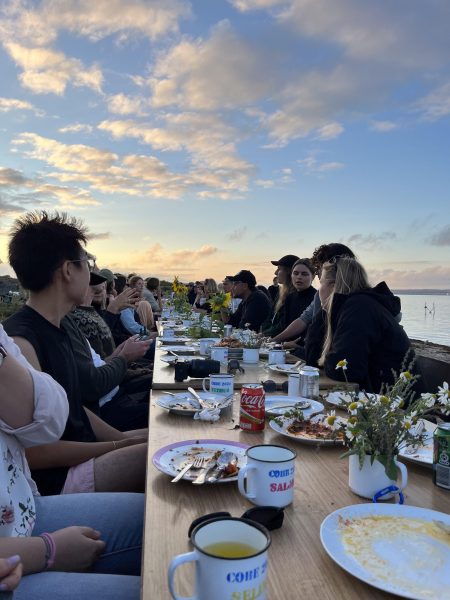
Trip to Koldinghus
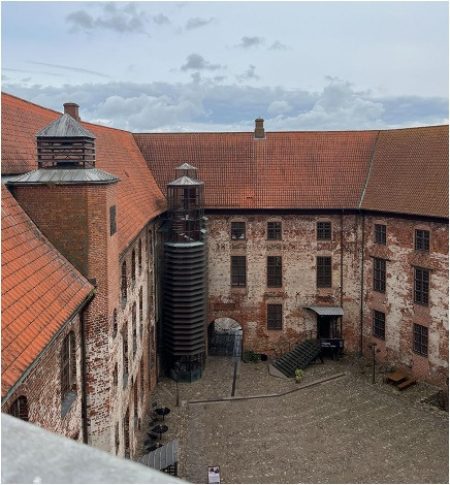
Between the connections made at Cobe and the ones already existing from my contacts at the UW School of Architecture, the list of must-see architectural gems in the region was long enough to keep me quite busy. My favorite of these architectural gems was when I visited Koldinghus in Kolding. Prior to my introduction to architecture, I had a distinct interest in sculptural artwork and ceramics. Because both ceramics and architecture play a major role in the craft and culture of Denmark, there was plenty around to inspire impressionable young designers like myself.
It was a somewhat gray day in Kolding when I stopped to see Koldinghus, but that didn’t stop myself and three hordes of schoolchildren from storming the castle and witnessing the brilliant layers of history on display around every corner. The star of the show was definitely Ruin Hall, which was a portion of the castle left exposed to the elements for decades before undergoing a major restoration designed by Inger and Johannes Exner in the 1990s. In order to protect the integrity of the crumbling brick walls, massive wooden columns support the hanging weight of new walls, stairs, bridges, and a mezzanine that reflect the geometry and layout of the wing before it was destroyed. It was amazing to see how many times the castle was destroyed and rebuilt, with each era being marked with a slightly different shade of red brick. Each brick is made of clay, and clay is a piece of the earth, which exists as a snapshot in the greater story of geological time. The castle bricks and stone sat together like a vivid collage of many different times and places all coexisting today in a single body of work.
One wing of the castle is home to the Royal Danish collection of fine china, and I couldn’t help but think that similar to the bricks around me, the intricately painted dinnerware was also once (and arguably still is) a piece of the earth. With this in mind, the Royal Danish collection started to feel more like a vessel within a vessel: sculpting one piece of earth to be housed inside the sculptural collage of another.
The architects behind the 1993 restoration of the castle, Inger and Johannes Exner, crafted many other sculptural masonry churches during the peak of late modernism. My visit to this castle sparked many interesting conversations with other visiting UW students and Cobe interns, culminating in a trip to more of their projects near Copenhagen. Seeing the many different ways brick can be expressed as a type of large-scale sculpture has inspired me to think about the material differently in both its expression and creative uses as a ceramic material.
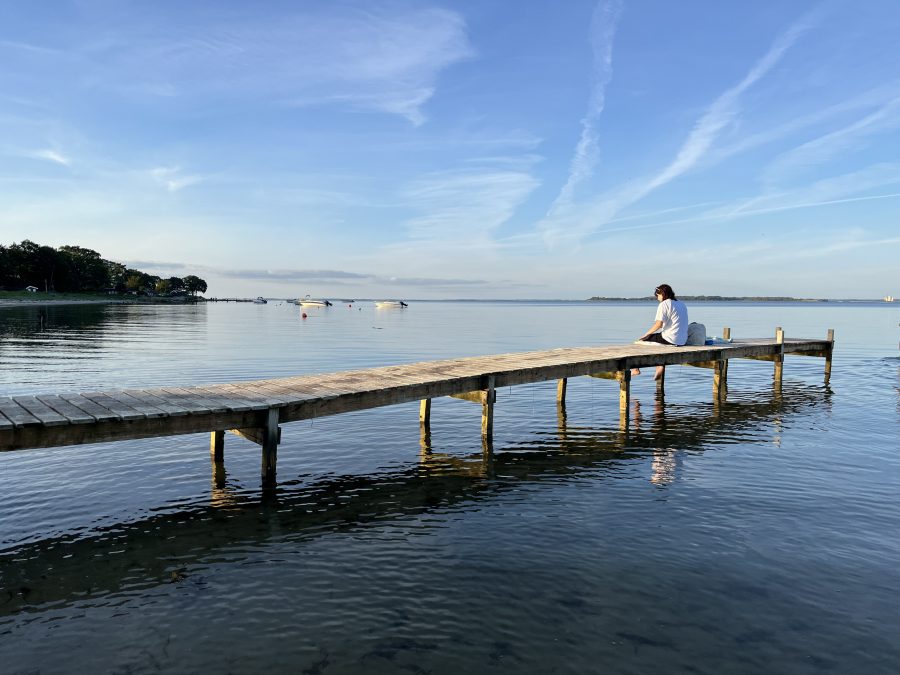
Out of the Office
Because I wanted to make the most of this time in Copenhagen, I also enrolled in a three-month Danish language class in the evenings. It was nice to see that the language class offered by the municipality was free for those who were interested, so I took the first introductory course with a wide variety of other expats who all had the same desire to, in varying degrees, become more integrated into Danish culture. Some were hoping to take the class for far longer and eventually pass the language proficiency test to gain a long-term visa, and others were students like me just hoping to pick up a little bit more of the language during their time there. This came to be a rather valued part of my time abroad because it was the first time I made connections of my own, independent of architecture, mutual friends, or academic institutions. The colleagues I met at studieskolen were my friends by the end of our class together.
Takeaways
These adventures truly would not have been possible without the support of the Scan Design Foundation. I am grateful for all of the experiences I was able to have in the past year due to the SDF, and am excited to see what doors have opened for me due to this experience. Not only was the Scan Design Foundation paramount in making this internship happen, but throughout my time in Denmark I was able to make connections that will propel me throughout the rest of my architecture career. From the beach of a small island to the top of an historic castle, I was able to gather so much insight about a plethora of design interventions that I am certain will become inspiration as I return to Seattle to embark on my architecture career.
